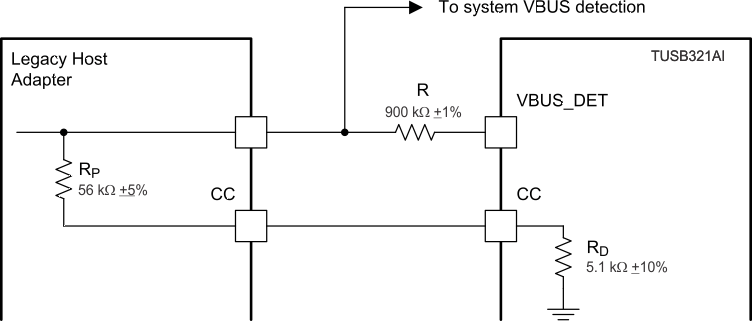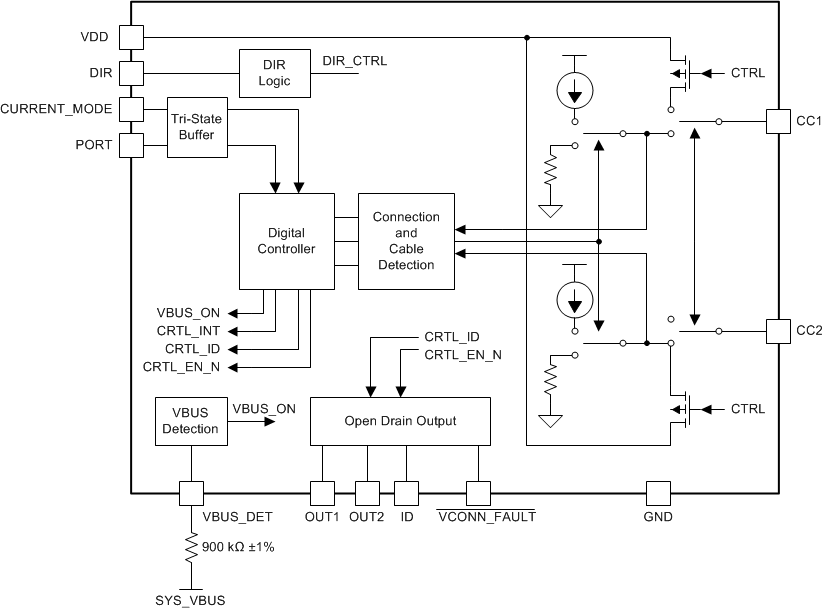ZHCSEB5 October 2015 TUSB321AI
PRODUCTION DATA.
7 Detailed Description
7.1 Overview
The USB Type-C ecosystem operates around a small form factor connector and cable that is flippable and reversible. Because of the nature of the connector, a scheme is needed to determine the connector orientation. Additional schemes are needed to determine when a USB port is attached and the acting role of the USB port (DFP, UFP, DRP), as well as to communicate Type-C current capabilities. These schemes are implemented over the CC pins according to the USB Type-C specifications. The TUSB321AI device provides Configuration Channel (CC) logic for determining USB port attach and detach, role detection, cable orientation, and Type-C current mode. The TUSB321AI device also contains several features such as VCONN sourcing, USB3.1 MUX direction control, mode configuration and low standby current which make this device ideal for source or sinks in USB2.0 or USB3.1 applications.
7.1.1 Cables, Adapters, and Direct Connect Devices
Type-C Specification 1.1 defines several cables, plugs and receptacles to be used to attach ports. The TUSB321AI device supports all cables, receptacles, and plugs. The TUSB321AI device does not support e-marking.
7.1.1.1 USB Type-C Receptacles and Plugs
Below is list of Type-C receptacles and plugs supported by the TUSB321AI device:
- USB Type-C receptacle for USB2.0 and USB3.1 and full-featured platforms and devices
- USB full-featured Type-C plug
- USB2.0 Type-C plug
7.1.1.2 USB Type-C Cables
Below is a list of Type-C cables types supported by the TUSB321AI device:
- USB full-featured Type-C cable with USB3.1 full-featured plug
- USB2.0 Type-C cable with USB2.0 plug
- Captive cable with either a USB full-featured plug or USB2.0 plug
7.1.1.3 Legacy Cables and Adapters
The TUSB321AI device supports legacy cable adapters as defined by the Type-C Specification. The cable adapter must correspond to the mode configuration of the TUSB321AI device.
 Figure 2. Legacy Adapter Implementation Circuit
Figure 2. Legacy Adapter Implementation Circuit
7.1.1.4 Direct Connect Devices
The TUSB321AI device supports the attaching and detaching of a direct-connect device.
7.2 Functional Block Diagram

7.3 Feature Description
7.3.1 Port Role Configuration
The TUSB321AI device can be configured as a downstream facing port (DFP), upstream facing port (UFP), or dualrole port (DRP) using the tri-level PORT pin. The PORT pin should be pulled high to VDD using a pullup resistance, low to GND or left as floated on the PCB to achieve the desired mode. This flexibility allows the TUSB321AI device to be used in a variety of applications. The TUSB321AI device samples the PORT pin after reset and maintains the desired mode until the TUSB321AI device is reset again. Table 1 lists the supported features in each mode:
Table 1. Supported Features for the TUSB321AI Device by Mode
| PORT PIN | HIGH (DFP ONLY) |
LOW (UFP ONLY) |
NC (DRP) |
|---|---|---|---|
| SUPPORTED FEATURES | |||
| Port attach and detach | Yes | Yes | Yes |
| Cable orientation | Yes | Yes | Yes |
| Current advertisement | Yes | - | Yes (DFP) |
| Current detection | - | Yes | Yes (UFP) |
| Active cable detection | Yes | - | Yes (DFP) |
| VCONN | Yes | - | Yes (DFP) |
| Legacy cables | Yes | Yes | Yes |
| VBUS detection | - | Yes | Yes (UFP) |
7.3.1.1 Downstream Facing Port (DFP) - Source
The TUSB321AI device can be configured as a DFP only by pulling the PORT pin high through a resistance to VDD. In DFP mode, the TUSB321AI device constantly presents Rps on both CC. In DFP mode, the TUSB321AI device advertises USB Type-C current based on the state of the CURRENT_MODE pin.
When configured as a DFP, the TUSB321AI can operate with older USB Type-C 1.0 devices except for a USB Type-C 1.0 DRP device. The TUSB321AI can not operate with a USB Type-C 1.0 DRP device. This limitation is a result of backwards compatibility problem between USB Type-C 1.1 DFP and a USB Type-C 1.0 DRP.
Please note that when TUSB321AI's VDD supply is not active, Rd will be presented on both CC pins. This will cause another DRP or DFP device to detect the TUSB321AI as a UFP. When VDD becomes active, the TUSB321AI will remove the Rd from CC pins and present Rp on both CC pins.
7.3.1.2 Upstream Facing Port (UFP) - Sink
The TUSB321AI device can be configured as a UFP only by pulling the PORT pin low to GND. In UFP mode, the TUSB321AI device constantly presents pulldown resistors (Rd) on both CC pins. The TUSB321AI device monitors the CC pins for the voltage level corresponding to the Type-C mode current advertisement by the connected DFP. The TUSB321AI device debounces the CC pins and wait for VBUS detection before successfully attaching. As a UFP, the TUSB321AI device detects and communicates the advertised current level of the DFP to the system through the OUT1 and OUT2 pins.
7.3.1.3 Dual Role Port (DRP)
The TUSB321AI device can be configured to operate as a DRP when the PORT pin is left floated on the PCB. In DRP mode, the TUSB321AI device toggles between operating as a DFP and a UFP. When functioning as a DFP in DRP mode, the TUSB321AI device complies with all operations as defined for a DFP according to the Type-C Specification. When presenting as a UFP in DRP mode, the TUSB321AI device operates as defined for a UFP according to the Type-C Specification.
7.3.2 Type-C Current Mode
The TUSB321AI device supports both advertising and detection of Type-C current. When TUSB321AI is a UFP or a DRP connected as a sink, the OUT1 and OUT2 pins are used to inform the system the detected USB Type-C current being broadcasted by the attached DFP. When TUSB321AI device is a DFP or a DRP connected as a source, the CURRENT_MODE pin is used to advertise the USB Type-C current. The current advertisement for the TUSB321AI device is 500 mA (for USB2.0) or 900 mA (for USB3.1) if CURRENT_MODE pin is left unconnected or pulled to GND. If a higher level of current is required, the CURRENT_MODE can be pulled up to VDD through a 500-kΩ resistor to advertise medium current at 1.5 A or pulled up to VDD through a 10-kΩ resistor to advertise high current at 3 A. Table 2 lists the Type-C current advertisements and detection.
Table 2. Type-C Current Advertisement and Detection
| TYPE-C CURRENT | UFP or DRP acting as UFP Current Detection |
DFP or DRP acting as DFP Current Advertisement |
|
|---|---|---|---|
| Default | 500 mA (USB2.0) 900 mA (USB3.1) |
OUT1 = High OUT2 = High (unattached) or Low (attached) |
CURRENT_MODE = L |
| Medium - 1.5 A | OUT1 = Low OUT2 = High |
CURRENT_MODE = M | |
| High - 3 A | OUT1 = Low OUT2 = Low |
CURRENT_MODE = H | |
7.3.3 VBUS Detection
The TUSB321AI device supports VBUS detection according to the Type-C Specification. VBUS detection is used to determine the attachment and detachment of a UFP. VBUS detection is also used to successfully resolve the role in DRP mode.
The system VBUS voltage must be routed through a 900-kΩ resistor to the VBUS_DET pin on the TUSB321AI device if the PORT pin is configured as a DRP or a UFP. If the TUSB321AI device is configured as a DFP and only ever used in DFP mode, the VBUS_DET pin can be left unconnected.
7.3.4 Cable Orientation and External MUX Control
The TUSB321AI device has the ability to control an external/discrete MUX using the DIR pin. The TUSB321AI detects the cable orientation by monitoring the voltage on the CC pins. When a voltage level within the proper threshold is detected on CC1, the DIR pin is pulled low. When a voltage level within the proper threshold is detected on CC2, the DIR is pulled high. If the direction polarity of the external MUX is opposite of the TUSB321AI, the CC1/CC2 connection to USB Type-C receptacle can be reversed. The DIR pin is an open drain output.
7.3.5 VCONN Support for Active Cables
The TUSB321AI device supplies VCONN to active cables when configured in DFP mode or in DRP acting as a DFP mode. VCONN is provided only when the unconnected CC pin is terminated to a resistance, Ra, and after a UFP is detected and the Attached.SRC state is entered. When in DFP mode or in DRP acting as a DFP mode, a 5-V source must be connected to the VDD pin of the TUSB321AI device after Attached.SRC. VCONN is supplied from VDD through a low resistance power FET out to the unconnected CC pin. VCONN is removed when a detach event is detected and the active cable is removed.
7.4 Device Functional Modes
The TUSB321AI device has three functional modes. Table 3 lists these modes:
Table 3. USB Type-C States According to TUSB321AI Functional Modes
| MODES | GENERAL BEHAVIOR | PORT PIN | STATES(1) |
|---|---|---|---|
| Unattached | USB port unattached. ID, PORT operational. CC pins configure according to PORT pin. | UFP | Unattached.SNK |
| AttachWait.SNK | |||
| DRP | Toggle Unattached.SNK → Unattached.SRC | ||
| AttachedWait.SRC or AttachedWait.SNK | |||
| DFP | Unattached.SRC | ||
| AttachWait.SRC | |||
| Active | USB port attached. All GPIOs operational. | UFP | Attached.SNK |
| DRP | Attached.SNK | ||
| Attached.SRC | |||
| DFP | Attached.SRC | ||
| Dead Battery | No operation. VDD not available | N/A | Default device state to UFP/SINK with Rd |
7.4.1 Unattached Mode
Unattached mode is the primary mode of operation for the TUSB321AI device, because a USB port can be unattached for a lengthy period of time. In unattached mode, VDD is available, and all IOs are operational. After the TUSB321AI device is powered up, the part enters unattached mode until a successful attach has been determined. Initially, right after power up, the TUSB321AI device comes up as an Unattached.SNK. The TUSB321AI device checks the PORT pin and operates according to the mode configuration. The TUSB321AI device toggles between the UFP and the DFP if configured as a DRP. The PORT pin is only sampled at reset or power up.
7.4.2 Active Mode
Active mode is defined as the port being attached. In active mode, all GPIOs are operational. When in active mode, the TUSB321AI device communicates to the AP that the USB port is attached. This happens through the ID pin if TUSB321AI is configured as a DFP or DRP connect as source. If TUSB321AI is configured as a UFP or a DRP connected as a sink, the OUT1 and OUT2 pins are used. The TUSB321AI device exits active mode under the following conditions:
- Cable unplug
- VBUS removal if attached as a UFP
7.4.3 Dead Battery Mode
Dead battery mode is defined as VDD not active. In this mode, CC pins always default to pull-down resistors. Dead battery means:
● TUSB321AI in UFP with 5.1 kΩ ±20% pull-down resistors